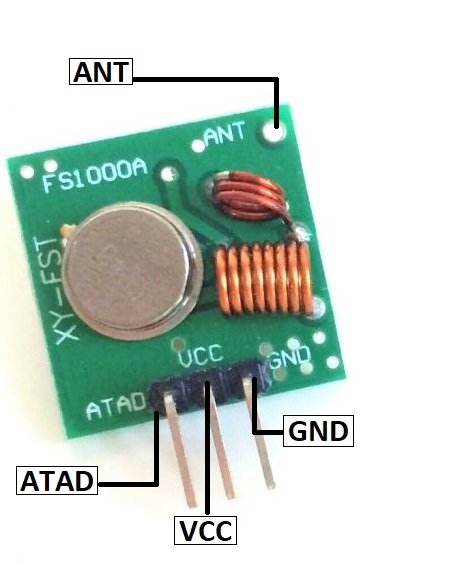433MHz RF Transmitter is one of the best and most efficient RF modules. It is simple to use and easy to implement. It is the first part of 433MHz RF communication. This module uses a serial data input and transmits it to the 3 Meter range but the range is extendable up to 100 Meters. The transmitter doesn’t operate on its own. It uses ASK (Amplitude Shift Keying) which makes it easy to interface with any microcontroller. In some microcontrollers, it needs to control through programming but some decoders also help to avoid complex programming. The dependency of the module on other devices is just due to the transmission of data in encoded form.
433MHz RF Transmitter Module Pinout Diagram
433MHz RF Transmitter Module consists of 4-pins which makes it operatable. This picture presents a pinout diagram of this RF transmitter module.
Pin Configuration details
All these pins are:
- VCC: This is the power input pin of the RF module to make it functional.
- GND: Ground pin helps the module to make the common ground with the controllers and encoder/decoders.
- ATAD: This is the data pin of the transmitter. It takes the data from the input device in encoded form and broadcast it.
- ANT: The antenna pin is not necessary to use. The module can operate max 3 meters without antenna but its range is also extendable up to 100 meters by using a small wire as an Antena.
433MHz RF Transmitter Module Features
- The Transmitter offers one-ways communication through 433.92MHz frequency at 1Kb data rate
- It operates at 3-12V which is the power operating volts of most of the microcontrollers and boards.
- The module uses the ASK modulation method to transmits the data.
- It is one of the low-cost power effective modules for both commercial and developers.
- 433MHz Transmitter is one of the oldest RF transmitters and it has a lot of applications and examples on the internet which helps to achieve the interfacing with almost every application.
Applications
- In IoT, RF Module helps to communicate between two devices.
- Car security systems come up with RF Transmitter.
- Home Security, especially for smoke and presence sensor, are interconnected through an RF module.
- RF module is used for both short and long-distance up to 100 meters.
How to use 433MHz RF Transmitter Module
To use the 433MHz RF transmitter module, there are two most common methods. The first method is with the use of the program and the second is through programming.
RF Transmitter programming Programming
Most of the devices, programming helps to communicate. In programming microcontrollers as the most common ones, which uses the RF modules. There is a list of libraries which helps to interface directly with the RF module:
- #include <REGx051.H> (C-language)
- #include <RH_ASK.h> (Arduino and STM32F103C8)
Check this complete tutorial for interfacing with Arduino:
These are the most common libraries but there are a lot of them which helps to the interface. These libraries are designable in any other language. The only thing the programmer needs to achieve the ASK for the module from the microcontroller. This may be a little difficult in some language that is why there is another hardware included method which is achievable by almost every language.
Encoder
The use of an encoder is the easiest method to send through the RF module. Today most people still like to use the encode because of its working probability of much higher than the programming. In encoding, the data input will be always a 4-bit that is achievable by any language. Then encoder automatically encodes the data for the RF module. In some devices like a car remote, home security, all those which have the same repeatable data uses only an encoder.
In a microcontroller, some devices also use the encoder to interface with them. They only need to send the data/words in 4-bits and the encoder will do the rest of the work. The 4-bit data can be generated through any digital pins or by the uses of libraries or any other method.
Dependency
The RF module always broadcasts the data in a specific range. Its other end-use a receiver with the same frequency. Both devices may have some data theft issue but it is removable by the use of multiple security methods like checkpoints, addresses, etc.
2D Diagram

Other Wireless Communication Modules


